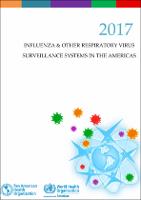Influenza and other respiratory virus surveillance systems in the Americas, 2017
Date
2017ISBN
978-92-75-07455-8
Metadata
Show full item recordOther Language Versions
Abstract
[Background]. Since the 2009 influenza pandemic, countries of the Americas have been strengthening their surveillance systems to improve detection of novel influenza subtypes and monitoring of seasonal influenza epidemics. These systems, when functioning optimally, allow public health decision makers to understand when, where, and who is being affected by influenza during seasonal epidemics and should detect the emergence of a novel influenza subtype in a timely manner. The first surveillance systems to be developed in most countries in the Region were laboratory-based surveillance systems, which would allow the detection of a novel influenza subtype if a clinical sample were collected and tested in the laboratory. Since this time, many other systems have been developed to complement and integrate with the laboratory surveillance platforms, which allow for monitoring of influenza, pneumonia, and clinical influenza proxy syndromes in the ambulatory and hospitalized settings (e.g. influenza-like illness [ILI] and severe acute respiratory infection [SARI]). There are systems which are both indicator-based as well as systems which rely upon event-based information (e.g., tracking of media reports).The result of these efforts is that now, there are a variety of systems that contribute to the understanding nationally, regionally, and globally, of influenza. This publication represents a compilation of the respiratory virus surveillance systems that exist in countries throughout the Americas Region and is an update to the 2014-publication, “Influenza and Other Respiratory Virus Surveillance Systems in the Americas, 2014”. he 2016-2017 inventory includes two sections: Regional Analyses and Country-by-country Analyses. The regional section includes regional data, maps showing capacities that exist in the region, and frequency of data reporting to FluID and FluNet...
Subject
Category of PAHO Strategic Plan 2014-2019
Collections
Related items
Showing items related by title, author, creator and subject.
-
Pan American Health Organization; Health Emergencies (PHE) (PAHOUnited StatesWashington, D.C., 2023)[WEEKLY SUMMARY]. North America: Influenza virus activity decreased overall, with the predominance of influenza B viruses. All seasonal influenza subtypes were detected. SARS-CoV-2 circulated at moderate levels, and RSV ...
-
Organización Panamericana de la Salud; Health Emergencies (PHE) (OPSUnited StatesWashington, D.C., 2023)[WEEKLY SUMMARY]. North America: Influenza activity has been on the rise, with Mexico reporting an increase in activity. Influenza B (Victoria lineage in cases where it has been determined) and influenza A (H1N1)pdm09 have ...
-
Pan American Health Organization; Health Emergencies (PHE) (PAHOUnited StatesWashington, D.C., 2023)[WEEKLY SUMMARY]. North America: Influenza virus activity decreased throughout the sub-region, with the predominance of influenza B viruses. All seasonal influenza subtypes were detected. SARS-CoV-2 circulates at moderate ...




